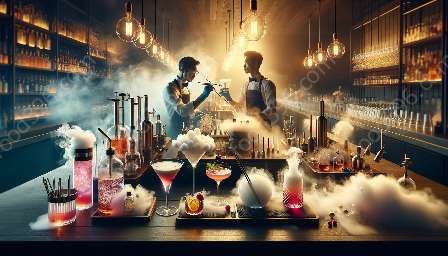Carbonation adds effervescence and depth to various drinks, transforming them into delightful and refreshing beverages. In the realm of molecular mixology and cocktail culture, carbonation techniques play a crucial role in enhancing the overall drinking experience. This article explores the art and science of carbonation, shedding light on its significance and impact.
The Science of Carbonation
Carbonation, in simple terms, is the process of dissolving carbon dioxide gas in a liquid, resulting in the formation of bubbles and the characteristic fizziness that we associate with carbonated drinks. This process can occur naturally, such as in naturally carbonated spring waters, or it can be intentionally induced through various techniques.
Traditional Carbonation Techniques
Historically, carbonation was achieved through natural fermentation processes, where yeast would consume sugars and produce carbon dioxide as a byproduct. This method is commonly used in the production of beers and sparkling wines, where the carbonation is a result of the secondary fermentation process.
In modern times, the most common carbonation technique involves the injection of carbon dioxide gas into the liquid under pressure. This method, known as force carbonation, is widely employed in the production of soft drinks, seltzers, and other carbonated beverages.
The Role of Molecular Mixology
Molecular mixology, a term that has gained significant traction in the world of cocktail culture, focuses on the application of scientific principles and techniques to create innovative and visually stunning drinks. Carbonation, being a fundamental aspect of mixology, has been reimagined through the lens of molecular gastronomy and modernist culinary techniques.
One notable development in molecular mixology is the use of carbon dioxide cartridges to infuse drinks with a controlled and precise amount of carbonation. This method allows mixologists to create bespoke carbonated cocktails and beverages, with the ability to adjust the level of effervescence according to their creative vision.
Carbonation Innovations in Cocktail Culture
The intersection of molecular mixology and cocktail culture has witnessed a surge in experimentation with carbonation techniques. Mixologists are exploring unconventional ways to carbonate drinks, often incorporating tools and equipment borrowed from the realm of molecular gastronomy.
Carbonation Equipment and Tools
Utilizing techniques such as vacuum carbonation, wherein a vacuum chamber is used to infuse liquids with carbon dioxide more rapidly and efficiently, mixologists are able to achieve a finer and more consistent carbonation profile in their drinks. This level of precision enhances the sensory experience and allows for greater control over the carbonation process.
Flavor Infusion through Carbonation
Another intriguing aspect of carbonation techniques in drinks is the potential for flavor infusion. By carbonating various ingredients, such as fruits, herbs, and spices, mixologists can create effervescent infusions that add layers of complexity and dimension to cocktails. This approach aligns with the ethos of molecular mixology, where flavor manipulation and enhancement are central to the craft.
Challenges and Opportunities
While the exploration of carbonation techniques in drinks offers exciting possibilities, it also presents challenges, particularly in terms of consistency and scalability. Achieving uniform carbonation levels across large batches of cocktails, for instance, demands a thorough understanding of the underlying principles and careful calibration of equipment.
However, the opportunities presented by advances in molecular mixology and cocktail culture outweigh these challenges. With the advent of specialized carbonation devices and the ongoing refinement of techniques, mixologists can continually push the boundaries of creativity and sensory experience.
Looking to the Future
The synergy between carbonation techniques, molecular mixology, and cocktail culture is shaping the future of beverage innovation. As technology and culinary science continue to converge, we can anticipate further developments in carbonation methods, leading to new expressions of flavor, texture, and visual appeal in drinks.
The Evolution of Carbonated Creations
From carbonated cocktails that showcase intricate layers of aroma and effervescence to non-alcoholic beverages that captivate the senses with their carbonated infusions, the possibilities are boundless. The evolution of carbonation techniques in drinks mirrors the evolution of mixology itself, ushering in an era of multisensory experiences and heightened creativity.
Community and Collaboration
As the pursuit of excellence in carbonation techniques gains momentum, the exchange of knowledge and techniques within the community of mixologists and beverage enthusiasts becomes increasingly vital. Collaborative efforts and shared insights will undoubtedly fuel the continued evolution of molecular mixology and cocktail culture.

